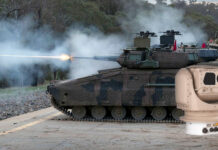(This item is dated January 2007, Click here for a more update version)
Update: Three MRAP Producers will Share future Orders Worth $8.2 Billion
The Pentagon plans to phase out its armored Humvees in Iraq and Afghanistan and send in vehicles that better withstand roadside bomb blasts, Defense Secretary Robert Gates said Wednesday (May 10, 2007).
The U.S. Navy evaluated nine suppliers for the procurement of Mine Resistant Ambush Protected (MRAP) trucks, destined to augment and later replace up-armored HMMWVs currently operating in Iraq and Afghanistan. The new vehicles provides much improved protection , specifically against Improvised Explosive Devices (IEDs), which cause 70% of all U.S. casualties in Iraq.
 The initial phase of the joint services program, expected to cost over US$2 billion is being managed by the US Marine Corps. However, given the poor performance of light armored vehicles in Iraq and AFghanistan, the realistic requirement for MRAP is currently estimated by the Marines to be in excess of 7,700 vehicles, worth an approximate $8.4 billion. Some 3,700 MRAPS will go to the USMC while the Army plans to buy 2,500. The Army is expected to get more than what it currently plans, if priorities are changed. MRAP is the “highest priority Department of Defense acquisition program,” Gates wrote in a memo send in early May 2007 to the secretaries of the Army and Navy.
The initial phase of the joint services program, expected to cost over US$2 billion is being managed by the US Marine Corps. However, given the poor performance of light armored vehicles in Iraq and AFghanistan, the realistic requirement for MRAP is currently estimated by the Marines to be in excess of 7,700 vehicles, worth an approximate $8.4 billion. Some 3,700 MRAPS will go to the USMC while the Army plans to buy 2,500. The Army is expected to get more than what it currently plans, if priorities are changed. MRAP is the “highest priority Department of Defense acquisition program,” Gates wrote in a memo send in early May 2007 to the secretaries of the Army and Navy.
Previous MRAP models (including Cougar JERRV and Buffalo mine protected trucks) are currently in service in Iraq and AFghanistan. These armored vehicles have a proven record of saving lives by augmenting the current level of mine, rocket propelled grenades and improvised explosive devices (IED) protection with a V-shaped hull and raised chassis.
Of the total 4,100 vehicles, 1500 will be Category I Mine Resistant Utility Vehicle (MRUV) (designed for the US Marines and U.S. Navy use) while 2,600 will be Category II Joint Explosive Ordnance Disposal Rapid Response Vehicle (JERRV) destined mostly for U.S. Army units. In total, the Army will get 2,500 vehicles, the USMC: 1,022 and Navy: 538. MRAP, considered to be better protected against IEDs, mines and, if required — RPGs, is expected to significantly improve the protection of troops deployed in Iraq and Afghanistan. The vehicle will use bullet-proof armor and are designed with V shaped hull, deflecting the blast effect created by mines or IED explosions.


The U.S. Navy program office has allocated over US$34.5 million for the initial evaluation phase of 36 vehicles. Nine contracts have been awarded last week to most producers of armored vehicles, excluding AM General, (AMG) the producers of the HMMWV, which will continue production of the lighter, Up Armored vehicle under existing programs. The joint venture between AMG and AMG Each company will deliver four test vehicles (two per category), within 60 days. Among the contractors are some of the well established names, such as BAE Systems, GDLS and Force protection, and truck producers Oshkosh, International and Stewart & Stevenson (Armor Holdings) but also smaller producers of special armored vehicles, such as New Haven, Michigan based GPV and PVI, based in North Charleston, S.C. The full list of MRAP contractors include:
- BAE Systems, Ground Systems Division –RG-31, RG-32, RG-33
- Oshkosh Truck Corporation
- Protected Vehicles, Inc. (PVI) – Golan
- General Dynamics Land Systems – Canada Corporation, Canada
- Force Protection Industries, Inc., Ladson, S.C. – Cougar
- Armor Holdings, Inc.
- Textron Marine & Land Systems, New Orleans, La. – ASV
- General Purpose Vehicles, LLC. (GPV)
- International Military and Government LLC (APC)

Due to the tight procurement schedule, only commercially available designs were considered. The vehicle should be designed for off-road and highway mobility, and be configured for personnel, cargo and litter transportation. The larger (JERRV) vehicle should have a payload capacity of 5,000 lbs, and will be able to carry 6 – 10 troops. The vehicle will be configured to carry existing gunner protected turrets or remotely controlled weapon stations, enabling the gunner to load, operate and engage targets from fully protected positions. To improve recovery after mine damage, the vehicle will be built of modular components that could break away from the vehicle in the case of a blast. Its energy absorbing seats should be capable of withstanding the accelerative effects of mine blasts.
The armor protection of the vehicle include mine protection and ballistic protection of the full, roof protection from overhead airburst and side protection against fragmentation and blast. The transparent armor windows will have protection level equal to or greater than that of the ballistic armor on the vehicle, and will have built-in gun-ports. RPG protection could also be an option.




















